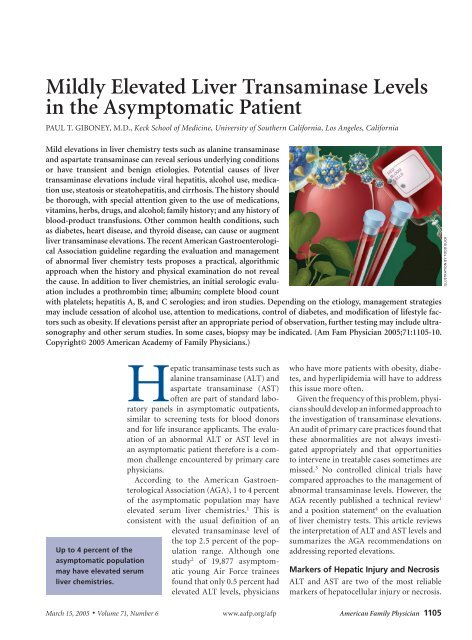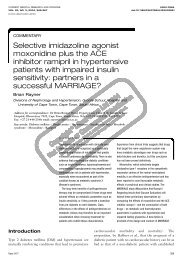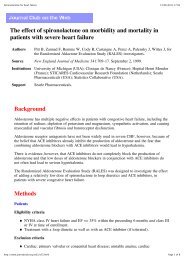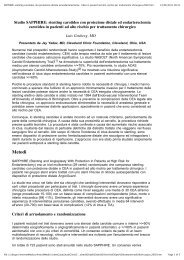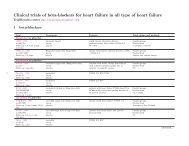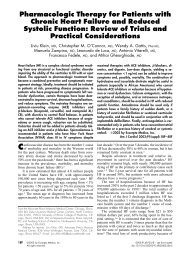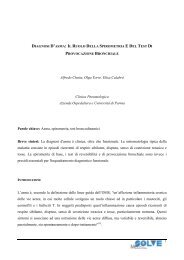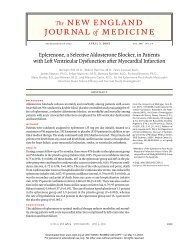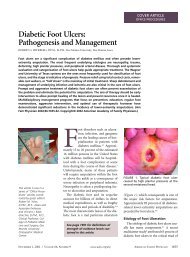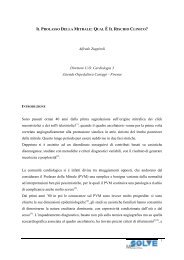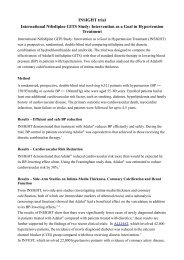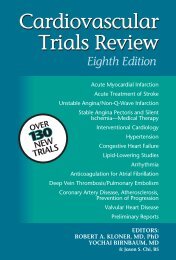Mildly Elevated Liver Transaminase Levels in the ... - Diegori.it
Mildly Elevated Liver Transaminase Levels in the ... - Diegori.it
Mildly Elevated Liver Transaminase Levels in the ... - Diegori.it
You also want an ePaper? Increase the reach of your titles
YUMPU automatically turns print PDFs into web optimized ePapers that Google loves.
<strong>Mildly</strong> <strong>Elevated</strong> <strong>Liver</strong> <strong>Transam<strong>in</strong>ase</strong> <strong>Levels</strong><br />
<strong>in</strong> <strong>the</strong> Asymptomatic Patient<br />
PAUL T. GIBONEY, M.D., Keck School of Medic<strong>in</strong>e, Univers<strong>it</strong>y of Sou<strong>the</strong>rn California, Los Angeles, California<br />
Mild elevations <strong>in</strong> liver chemistry tests such as alan<strong>in</strong>e transam<strong>in</strong>ase<br />
and aspartate transam<strong>in</strong>ase can reveal serious underly<strong>in</strong>g cond<strong>it</strong>ions<br />
or have transient and benign etiologies. Potential causes of liver<br />
transam<strong>in</strong>ase elevations <strong>in</strong>clude viral hepat<strong>it</strong>is, alcohol use, medication<br />
use, steatosis or steatohepat<strong>it</strong>is, and cirrhosis. The history should<br />
be thorough, w<strong>it</strong>h special attention given to <strong>the</strong> use of medications,<br />
v<strong>it</strong>am<strong>in</strong>s, herbs, drugs, and alcohol; family history; and any history of<br />
blood-product transfusions. O<strong>the</strong>r common health cond<strong>it</strong>ions, such<br />
as diabetes, heart disease, and thyroid disease, can cause or augment<br />
liver transam<strong>in</strong>ase elevations. The recent American Gastroenterological<br />
Association guidel<strong>in</strong>e regard<strong>in</strong>g <strong>the</strong> evaluation and management<br />
of abnormal liver chemistry tests proposes a practical, algor<strong>it</strong>hmic<br />
approach when <strong>the</strong> history and physical exam<strong>in</strong>ation do not reveal<br />
<strong>the</strong> cause. In add<strong>it</strong>ion to liver chemistries, an <strong>in</strong><strong>it</strong>ial serologic evaluation<br />
<strong>in</strong>cludes a prothromb<strong>in</strong> time; album<strong>in</strong>; complete blood count<br />
w<strong>it</strong>h platelets; hepat<strong>it</strong>is A, B, and C serologies; and iron studies. Depend<strong>in</strong>g on <strong>the</strong> etiology, management strategies<br />
may <strong>in</strong>clude cessation of alcohol use, attention to medications, control of diabetes, and modification of lifestyle factors<br />
such as obes<strong>it</strong>y. If elevations persist after an appropriate period of observation, fur<strong>the</strong>r test<strong>in</strong>g may <strong>in</strong>clude ultrasonography<br />
and o<strong>the</strong>r serum studies. In some cases, biopsy may be <strong>in</strong>dicated. (Am Fam Physician 2005;71:1105-10.<br />
Copyright© 2005 American Academy of Family Physicians.)<br />
ILLUSTRATION BY TODD BUCK<br />
Hepatic transam<strong>in</strong>ase tests such as<br />
alan<strong>in</strong>e transam<strong>in</strong>ase (ALT) and<br />
aspartate transam<strong>in</strong>ase (AST)<br />
often are part of standard laboratory<br />
panels <strong>in</strong> asymptomatic outpatients,<br />
similar to screen<strong>in</strong>g tests for blood donors<br />
and for life <strong>in</strong>surance applicants. The evaluation<br />
of an abnormal ALT or AST level <strong>in</strong><br />
an asymptomatic patient <strong>the</strong>refore is a common<br />
challenge encountered by primary care<br />
physicians.<br />
Accord<strong>in</strong>g to <strong>the</strong> American Gastroenterological<br />
Association (AGA), 1 to 4 percent<br />
of <strong>the</strong> asymptomatic population may have<br />
elevated serum liver chemistries. 1 This is<br />
consistent w<strong>it</strong>h <strong>the</strong> usual def<strong>in</strong><strong>it</strong>ion of an<br />
elevated transam<strong>in</strong>ase level of<br />
<strong>the</strong> top 2.5 percent of <strong>the</strong> population<br />
range. Although one<br />
Up to 4 percent of <strong>the</strong><br />
asymptomatic population study 2 of 19,877 asymptomatic<br />
young Air Force tra<strong>in</strong>ees<br />
may have elevated serum<br />
liver chemistries.<br />
found that only 0.5 percent had<br />
elevated ALT levels, physicians<br />
who have more patients w<strong>it</strong>h obes<strong>it</strong>y, diabetes,<br />
and hyperlipidemia will have to address<br />
this issue more often.<br />
Given <strong>the</strong> frequency of this problem, physicians<br />
should develop an <strong>in</strong>formed approach to<br />
<strong>the</strong> <strong>in</strong>vestigation of transam<strong>in</strong>ase elevations.<br />
An aud<strong>it</strong> of primary care practices found that<br />
<strong>the</strong>se abnormal<strong>it</strong>ies are not always <strong>in</strong>vestigated<br />
appropriately and that opportun<strong>it</strong>ies<br />
to <strong>in</strong>tervene <strong>in</strong> treatable cases sometimes are<br />
missed. 3 No controlled cl<strong>in</strong>ical trials have<br />
compared approaches to <strong>the</strong> management of<br />
abnormal transam<strong>in</strong>ase levels. However, <strong>the</strong><br />
AGA recently published a technical review 1<br />
and a pos<strong>it</strong>ion statement 4 on <strong>the</strong> evaluation<br />
of liver chemistry tests. This article reviews<br />
<strong>the</strong> <strong>in</strong>terpretation of ALT and AST levels and<br />
summarizes <strong>the</strong> AGA recommendations on<br />
address<strong>in</strong>g reported elevations.<br />
Markers of Hepatic Injury and Necrosis<br />
ALT and AST are two of <strong>the</strong> most reliable<br />
markers of hepatocellular <strong>in</strong>jury or necrosis.<br />
March 15, 2005 ◆ Volume 71, Number 6 www.aafp.org/afp American Family Physician 1105
Strength of Recommendations<br />
Key cl<strong>in</strong>ical recommendation Label References<br />
An algor<strong>it</strong>hmic approach to evaluat<strong>in</strong>g mildly C 1<br />
abnormal liver functions is recommended.<br />
In <strong>the</strong> asymptomatic patient w<strong>it</strong>h negative serum C 1<br />
test<strong>in</strong>g and mild transam<strong>in</strong>ase elevations, a period<br />
of lifestyle modification can be tried.<br />
If abnormal<strong>it</strong>ies persist at <strong>the</strong> six-month followup<br />
C 1<br />
vis<strong>it</strong>, an ultrasonography of <strong>the</strong> liver is <strong>the</strong><br />
recommended imag<strong>in</strong>g modal<strong>it</strong>y.<br />
ALT and AST are not useful screen<strong>in</strong>g tests <strong>in</strong> an C 1, 10<br />
o<strong>the</strong>rwise healthy population.<br />
The ALT/AST ratio is only somewhat helpful <strong>in</strong><br />
diagnosis.<br />
C 5, 7<br />
ALT = alan<strong>in</strong>e transam<strong>in</strong>ase; AST = aspartate transam<strong>in</strong>ase.<br />
A = consistent, good-qual<strong>it</strong>y patient-oriented evidence; B = <strong>in</strong>consistent or lim<strong>it</strong>edqual<strong>it</strong>y<br />
patient-oriented evidence; C = consensus, disease-oriented evidence, usual<br />
practice, op<strong>in</strong>ion, or case series. See page 1046 for more <strong>in</strong>formation.<br />
The Author<br />
PAUL T. GIBONEY, M.D., is assistant professor of cl<strong>in</strong>ical family medic<strong>in</strong>e at <strong>the</strong><br />
Keck School of Medic<strong>in</strong>e, Univers<strong>it</strong>y of Sou<strong>the</strong>rn California, Los Angeles. He<br />
received his medical degree from Northwestern Univers<strong>it</strong>y School of Medic<strong>in</strong>e,<br />
Chicago, and completed a residency <strong>in</strong> family medic<strong>in</strong>e at John Peter Sm<strong>it</strong>h<br />
Hosp<strong>it</strong>al, Fort Worth, Tex.<br />
Address correspondence to Paul T. Giboney, M.D., 123 S. Alvarado St., Los<br />
Angeles, CA 90057. Repr<strong>in</strong>ts are not available from <strong>the</strong> author.<br />
TABLE 1<br />
Etiology of ALT or AST Elevations<br />
When Less Than Five Times Normal<br />
Common hepatic causes<br />
Alcohol<br />
Cirrhosis<br />
Hepat<strong>it</strong>is B (chronic)<br />
Hepat<strong>it</strong>is C (chronic)<br />
Steatosis/steatohepat<strong>it</strong>is<br />
Medications/tox<strong>in</strong>s<br />
Acute viral hepat<strong>it</strong>is<br />
Less common hepatic causes<br />
Autoimmune hepat<strong>it</strong>is<br />
Hemochromatosis<br />
Alpha 1 -ant<strong>it</strong>ryps<strong>in</strong> deficiency<br />
Wilson’s disease<br />
Nonhepatic causes<br />
Celiac disease<br />
Hemolysis<br />
Myopathy<br />
Hyperthyroidism<br />
Strenuous exercise<br />
Macro-AST<br />
ALT = alan<strong>in</strong>e transam<strong>in</strong>ase; AST = aspartate transam<strong>in</strong>ase.<br />
Adapted w<strong>it</strong>h permission from Pratt DS, Kaplan MM.<br />
Evaluation of abnormal liver-enzyme results <strong>in</strong> asymptomatic<br />
patients. N Engl J Med 2000;342:1267, w<strong>it</strong>h<br />
add<strong>it</strong>ional <strong>in</strong>formation from reference 5.<br />
Their levels can be elevated <strong>in</strong> a variety of<br />
hepatic disorders. Of <strong>the</strong> two, ALT is thought<br />
to be more specific for hepatic <strong>in</strong>jury because<br />
<strong>it</strong> is present ma<strong>in</strong>ly <strong>in</strong> <strong>the</strong> cytosol of <strong>the</strong> liver<br />
and <strong>in</strong> low concentrations elsewhere. AST<br />
has cytosolic and m<strong>it</strong>ochondrial forms and<br />
is present <strong>in</strong> tissues of <strong>the</strong> liver, heart, skeletal<br />
muscle, kidneys, bra<strong>in</strong>, pancreas, and<br />
lungs, and <strong>in</strong> wh<strong>it</strong>e and red blood cells. AST<br />
is less commonly referred to as serum glutamic<br />
oxaloacetic transam<strong>in</strong>ase and ALT as<br />
serum glutamic pyruvic transam<strong>in</strong>ase.<br />
Although levels of ALT and AST can be<br />
extremely elevated (exceed<strong>in</strong>g 2,000 U per L<br />
<strong>in</strong> cases of hepatocyte <strong>in</strong>jury and necrosis<br />
related to drugs, tox<strong>in</strong>s, ischemia, and<br />
hepat<strong>it</strong>is), elevations less than five times <strong>the</strong><br />
upper lim<strong>it</strong> of normal (i.e., about 250 U per L<br />
and below) are much more common <strong>in</strong> primary<br />
care medic<strong>in</strong>e. The range of possible<br />
etiologies at this level of transam<strong>in</strong>ase elevation<br />
is broader (Table 1 5,6 ) and <strong>the</strong> tests less<br />
specific. It also is important to recall that<br />
patients w<strong>it</strong>h normal ALT and AST levels<br />
can have significant liver disease <strong>in</strong> <strong>the</strong> sett<strong>in</strong>g<br />
of chronic hepatocyte <strong>in</strong>jury (e.g., cirrhosis,<br />
hepat<strong>it</strong>is C).<br />
The ratio of ALT to AST has some cl<strong>in</strong>ical<br />
util<strong>it</strong>y, but has important lim<strong>it</strong>ations. In many<br />
forms of acute and chronic liver <strong>in</strong>jury or steatosis<br />
(fatty <strong>in</strong>filtration of <strong>the</strong> liver), <strong>the</strong> ratio<br />
is less than or equal to 1. This is particularly<br />
true <strong>in</strong> patients w<strong>it</strong>h hepat<strong>it</strong>is C. However, an<br />
ALT/AST ratio greater than 2 characteristically<br />
is present <strong>in</strong> alcoholic hepat<strong>it</strong>is. A recent study 7<br />
of 140 patients w<strong>it</strong>h nonalcoholic steatohepat<strong>it</strong>is<br />
(NASH; confirmed by liver biopsy) or<br />
1106 American Family Physician www.aafp.org/afp Volume 71, Number 6 ◆ March 15, 2005
<strong>Elevated</strong> <strong>Transam<strong>in</strong>ase</strong> <strong>Levels</strong><br />
alcoholic liver disease found a mean ALT/AST<br />
ratio of 0.9 <strong>in</strong> patients w<strong>it</strong>h NASH and 2.6 <strong>in</strong><br />
patients w<strong>it</strong>h alcoholic liver disease. W<strong>it</strong>h<strong>in</strong><br />
<strong>the</strong> population studied, 87 percent of patients<br />
w<strong>it</strong>h an ALT/AST ratio of 1.3 or less had NASH<br />
(87 percent sens<strong>it</strong>iv<strong>it</strong>y, 84 percent specific<strong>it</strong>y).<br />
The sever<strong>it</strong>y of NASH as measured by<br />
<strong>the</strong> degree of fibrosis <strong>in</strong>creased, as did <strong>the</strong><br />
ALT/AST ratio. A mean ratio of 1.4 was found<br />
<strong>in</strong> patients w<strong>it</strong>h cirrhosis related to NASH.<br />
Wilson’s disease, a rare problem, can cause <strong>the</strong><br />
ALT/AST ratio to exceed 4. 5 While <strong>the</strong>se ratios<br />
are suggestive of certa<strong>in</strong> cond<strong>it</strong>ions, <strong>the</strong>re is<br />
too much overlap between groups to rely on<br />
<strong>the</strong>m exclusively when mak<strong>in</strong>g a diagnosis.<br />
Lactate dehydrogenase (LDH) is a less specific<br />
marker of hepatocellular necrosis and<br />
usually does not add diagnostic <strong>in</strong>formation<br />
to that obta<strong>in</strong>ed w<strong>it</strong>h ALT and AST test<strong>in</strong>g.<br />
An exception to this is <strong>the</strong> transient but massive<br />
rise of LDH <strong>in</strong> cases of ischemic hepat<strong>it</strong>is<br />
and <strong>it</strong>s susta<strong>in</strong>ed elevation that, along w<strong>it</strong>h<br />
elevated alkal<strong>in</strong>e phosphatase levels, suggests<br />
malignant <strong>in</strong>filtration of <strong>the</strong> liver. 5<br />
Elevations of ALT and AST are not exclusive<br />
to liver pathology. Hyperthyroidism has<br />
been found <strong>in</strong> several studies to <strong>in</strong>crease<br />
serum levels of liver enzymes <strong>in</strong>clud<strong>in</strong>g ALT<br />
and AST. 8 Genetic <strong>in</strong>fluences on <strong>the</strong> level of<br />
ALT also are possible. A study 9 of Danish<br />
tw<strong>in</strong>s showed that genetic factors accounted<br />
for 33 to 66 percent of <strong>the</strong> variation <strong>in</strong> ALT,<br />
gamma glutamyl transpeptidase, LDH, and<br />
bilirub<strong>in</strong> <strong>in</strong> patients 73 to 94 years of age.<br />
The AGA technical review states that serum<br />
ALT has diurnal variation, may vary day to<br />
day, and may be affected by exercise. It also<br />
notes that serum AST may be 15 percent<br />
higher <strong>in</strong> black men than wh<strong>it</strong>e men. 1<br />
Ano<strong>the</strong>r cause of elevated liver transam<strong>in</strong>ase<br />
levels is muscle <strong>in</strong>jury. Strenuous<br />
exercise or myopathy can cause elevations<br />
(especially of AST) w<strong>it</strong>hout caus<strong>in</strong>g any<br />
o<strong>the</strong>r symptoms. A creat<strong>in</strong>e k<strong>in</strong>ase or o<strong>the</strong>r<br />
muscle marker can be obta<strong>in</strong>ed to confirm<br />
or exclude such a process.<br />
Annual screen<strong>in</strong>g of healthy, asymptomatic<br />
patients for liver disease us<strong>in</strong>g ALT and<br />
AST levels is not useful. A Japanese study 10<br />
assessed <strong>the</strong> accuracy of ALT and AST for<br />
detect<strong>in</strong>g hepat<strong>it</strong>is C, excess alcohol use,<br />
and fatty liver disease <strong>in</strong> male<br />
bank employees and found <strong>the</strong><br />
pos<strong>it</strong>ive predictive value of <strong>the</strong><br />
test to be low. Only 3.9 percent<br />
of <strong>the</strong> men w<strong>it</strong>h an abnormal<br />
ALT level had hepat<strong>it</strong>is C; 8<br />
percent were excessive users of<br />
alcohol; and 35.7 percent had<br />
fatty liver.<br />
Management<br />
A thorough medical history and physical<br />
exam<strong>in</strong>ation are <strong>the</strong> cornerstone of <strong>the</strong><br />
evaluation of patients w<strong>it</strong>h mildly elevated<br />
liver transam<strong>in</strong>ase levels. 1 The history should<br />
attempt to identify risk factors for disease,<br />
w<strong>it</strong>h special attention directed toward family<br />
history, medications, v<strong>it</strong>am<strong>in</strong>s, herbal<br />
supplements, drug use, alcohol use, abnormal<br />
liver test<strong>in</strong>g, blood-product transfusions,<br />
and symptoms of liver disease. Table 2 6 lists<br />
selected medications and herbal supplements<br />
that may cause elevated transam<strong>in</strong>ase levels.<br />
Physicians should ask patients directly<br />
about <strong>the</strong>ir use of illic<strong>it</strong> drugs, herbal supplements,<br />
and o<strong>the</strong>r alternative “supplements”<br />
ALT is thought to be more<br />
specific than AST for<br />
hepatic <strong>in</strong>jury because <strong>it</strong> is<br />
present ma<strong>in</strong>ly <strong>in</strong> <strong>the</strong> cytosol<br />
of <strong>the</strong> liver and <strong>in</strong> low<br />
concentrations elsewhere.<br />
TABLE 2<br />
Common Agents That Can Cause <strong>Liver</strong> <strong>Transam<strong>in</strong>ase</strong><br />
Elevations<br />
Medications<br />
Acetam<strong>in</strong>ophen<br />
Amiodarone (Cordarone)<br />
Amoxicill<strong>in</strong>- clavulanic acid<br />
Carbamazep<strong>in</strong>e (Tegretol)<br />
Fluconazole (Diflucan)<br />
Glyburide (Micronase)<br />
Hepar<strong>in</strong><br />
Isoniazid (INH)<br />
Ketoconazole (Nizoral)<br />
Labetalol (Normodyne)<br />
N<strong>it</strong>rofuranto<strong>in</strong> (Furadant<strong>in</strong>)<br />
Nonsteroidal anti-<strong>in</strong>flammatory drugs<br />
Phenyto<strong>in</strong> (Dilant<strong>in</strong>)<br />
Protease <strong>in</strong>hib<strong>it</strong>ors<br />
Sulfonamides<br />
Trazodone (Desyrel)<br />
Information from reference 6.<br />
Herbal supplements/v<strong>it</strong>am<strong>in</strong>s<br />
Chaparral leaf<br />
Ephedra<br />
Gentian<br />
Germander<br />
J<strong>in</strong> bu huan<br />
Kava<br />
Scutellaria (skullcap)<br />
Senna<br />
Shark cartilage<br />
V<strong>it</strong>am<strong>in</strong> A<br />
March 15, 2005 ◆ Volume 71, Number 6 www.aafp.org/afp American Family Physician 1107
TABLE 3<br />
Clues <strong>in</strong> <strong>the</strong> Evaluation of <strong>Mildly</strong> <strong>Elevated</strong> <strong>Liver</strong><br />
<strong>Transam<strong>in</strong>ase</strong> <strong>Levels</strong><br />
Cl<strong>in</strong>ical clue<br />
Longstand<strong>in</strong>g alcohol abuse<br />
Intravenous drug use, history of blood<br />
product transfusions, nonsterile needle<br />
exposure, ALT/AST ratio < 1.0<br />
Obes<strong>it</strong>y, diabetes, hyperlipidemia, ALT/AST<br />
ratio < 1.0<br />
ALT/AST ratio > 2.0<br />
Increased iron levels<br />
Polypharmacy, illic<strong>it</strong> drug use, or certa<strong>in</strong><br />
herbal supplement use<br />
Frequent, strenuous exercise<br />
Intest<strong>in</strong>al bloat<strong>in</strong>g; oily, bulky stools<br />
Hypergammaglobul<strong>in</strong>emia<br />
Reduced ceruloplasm<strong>in</strong> levels, Kayser-<br />
Fleischer r<strong>in</strong>g<br />
Depressed thyroid-stimulat<strong>in</strong>g hormone levels<br />
ALT = alan<strong>in</strong>e transam<strong>in</strong>ase; AST = aspartate transam<strong>in</strong>ase.<br />
Suggested diagnosis<br />
Cirrhosis<br />
Hepat<strong>it</strong>is B or C<br />
Steatosis/steatohepat<strong>it</strong>is<br />
Alcoholic liver disease,<br />
Wilson’s disease<br />
Hemochromatosis<br />
Substance/<br />
medication-<strong>in</strong>duced<br />
Exercise-<strong>in</strong>duced<br />
Celiac sprue<br />
Autoimmune hepat<strong>it</strong>is<br />
Wilson’s disease<br />
Hyperthyroidism<br />
because <strong>the</strong>se sometimes are om<strong>it</strong>ted from<br />
<strong>the</strong> patient’s <strong>in</strong><strong>it</strong>ial response to questions.<br />
The presence of o<strong>the</strong>r significant health<br />
cond<strong>it</strong>ions that can cause or augment liver<br />
transam<strong>in</strong>ase elevations also should be<br />
noted; examples are diabetes, heart disease<br />
(<strong>in</strong>clud<strong>in</strong>g congestive heart failure), thyroid<br />
disease, muscle disease, and cancer. Physical<br />
f<strong>in</strong>d<strong>in</strong>gs and sequelae of liver dysfunction<br />
are given <strong>in</strong> Table 3.<br />
Once <strong>the</strong> history and physical exam<strong>in</strong>ation<br />
are completed, add<strong>it</strong>ional test<strong>in</strong>g can<br />
help discern <strong>the</strong> etiology of <strong>the</strong> transam<strong>in</strong>ase<br />
elevation (Figure 1). 4<br />
INITIAL LABORATORY EVALUATION<br />
Add<strong>it</strong>ional laboratory tests should be<br />
obta<strong>in</strong>ed when <strong>the</strong> history and physical<br />
exam<strong>in</strong>ation show no obvious etiology for<br />
ALT and AST elevations. Ferr<strong>it</strong><strong>in</strong>, total ironb<strong>in</strong>d<strong>in</strong>g<br />
capac<strong>it</strong>y, and serum iron can be<br />
used to look for hemochromatosis, while<br />
hepat<strong>it</strong>is A, B, and C serologies are used to<br />
rule out acute or chronic hepat<strong>it</strong>is.<br />
Desp<strong>it</strong>e <strong>the</strong> emergence of widespread vacc<strong>in</strong>ation,<br />
hepat<strong>it</strong>is B rema<strong>in</strong>s a common<br />
cause of chronic liver disease <strong>in</strong> adults. Test<strong>in</strong>g<br />
for hepat<strong>it</strong>is C is essential because <strong>it</strong>s<br />
<strong>in</strong>cidence has <strong>in</strong>creased <strong>in</strong> <strong>the</strong> past decade,<br />
and new treatment strategies have been<br />
developed that can address this frequently<br />
missed problem. 11<br />
A prothromb<strong>in</strong> time (PT) and serum<br />
album<strong>in</strong> should be ordered to identify<br />
patients w<strong>it</strong>h abnormal<strong>it</strong>ies of prote<strong>in</strong><br />
syn<strong>the</strong>sis and liver function. Evaluation<br />
should be accelerated for patients w<strong>it</strong>h<br />
impaired hepatic syn<strong>the</strong>tic function. A<br />
complete blood count w<strong>it</strong>h platelets also<br />
should be ordered. In add<strong>it</strong>ion to rul<strong>in</strong>g<br />
out <strong>in</strong>fection, neutropenia or thrombocytopenia<br />
can, along w<strong>it</strong>h an elevated<br />
PT, suggest advanced liver disease. An<br />
elevated mean red cell volume suggests<br />
heavy alcohol <strong>in</strong>take. Alkal<strong>in</strong>e phosphatase<br />
and bilirub<strong>in</strong> are markers for hepatic<br />
cholestasis and should be ordered as part<br />
of <strong>the</strong> <strong>in</strong><strong>it</strong>ial laboratory evaluation. While<br />
sometimes useful, <strong>the</strong>y often are normal<br />
<strong>in</strong> <strong>the</strong> presence of hepatic <strong>in</strong>jury.<br />
LIFESTYLE MODIFICATION<br />
If <strong>the</strong> patient is asymptomatic and <strong>the</strong> <strong>in</strong><strong>it</strong>ial<br />
serum test<strong>in</strong>g is negative, a period of lifestyle<br />
modification can be attempted. Effective lifestyle<br />
modification <strong>in</strong>cludes complete abst<strong>in</strong>ence<br />
from alcohol, control of diabetes and<br />
hyperlipidemia, weight loss <strong>in</strong> overweight<br />
patients, and stopp<strong>in</strong>g or chang<strong>in</strong>g potentially<br />
hepatotoxic medications and supplements.<br />
Such lifestyle changes directly impact<br />
several of <strong>the</strong> causes of mild transam<strong>in</strong>ase<br />
elevation (Table 1). 5,6 These seem<strong>in</strong>gly small<br />
modifications may be all that is needed to<br />
correct <strong>the</strong> abnormal<strong>it</strong>ies.<br />
FOLLOW-UP AND IMAGING STUDIES<br />
A repeat set of liver chemistries should be<br />
obta<strong>in</strong>ed after six months. If <strong>the</strong> patient’s<br />
presentation changes or <strong>the</strong> physician has<br />
concern for an evolv<strong>in</strong>g process, shorter<br />
<strong>in</strong>tervals can be used. If abnormal<strong>it</strong>ies persist<br />
at <strong>the</strong> six-month follow-up vis<strong>it</strong>, ultrasonography<br />
of <strong>the</strong> liver is recommended.<br />
Computed tomography of <strong>the</strong> abdomen also<br />
is used <strong>in</strong> this sett<strong>in</strong>g, although cl<strong>in</strong>ical trials<br />
1108 American Family Physician www.aafp.org/afp Volume 71, Number 6 ◆ March 15, 2005
<strong>Elevated</strong> <strong>Transam<strong>in</strong>ase</strong> <strong>Levels</strong><br />
Management of Mild ALT and AST Abnormal<strong>it</strong>ies<br />
<strong>Elevated</strong> ALT and AST less than five times normal<br />
History and physical exam<strong>in</strong>ation;<br />
discont<strong>in</strong>ue hepatotoxic medications and alcohol.<br />
Confirm abnormal<strong>it</strong>y if an error is suspected.<br />
<strong>Liver</strong> chemistries; prothromb<strong>in</strong> time; album<strong>in</strong>; complete blood count w<strong>it</strong>h platelets;<br />
hepat<strong>it</strong>is A, B, and C serologies; serum iron; total iron-b<strong>in</strong>d<strong>in</strong>g capac<strong>it</strong>y; ferr<strong>it</strong><strong>in</strong><br />
Exped<strong>it</strong>ed evaluation<br />
Negative serology<br />
Evidence of chronic liver<br />
disease or hepatic<br />
decompensation<br />
If abnormal, proceed<br />
w<strong>it</strong>h directed<br />
evaluation/treatment<br />
Negative serology, asymptomatic<br />
patient w<strong>it</strong>hout hepatic decompensation<br />
Lifestyle modification: discont<strong>in</strong>ue alcohol use,<br />
stop hepatotoxic medications, weight loss,<br />
diabetes control<br />
Six-month follow-up<br />
Repeat liver chemistries Normal Observation<br />
Abnormal<br />
Ultrasonography and serologic evaluation:<br />
ant<strong>in</strong>uclear antibodies, anti–smooth-muscle<br />
antibody, ceruloplasm<strong>in</strong>, alpha 1 -ant<strong>it</strong>ryps<strong>in</strong>,<br />
antigliad<strong>in</strong>, and antiendomysial antibody<br />
<strong>Liver</strong> biopsy<br />
Figure 1. Algor<strong>it</strong>hm to manage mild ALT and AST abnormal<strong>it</strong>ies. (ALT = alan<strong>in</strong>e transam<strong>in</strong>ase;<br />
AST = aspartate transam<strong>in</strong>ase.)<br />
Adapted w<strong>it</strong>h permission from American Gastroenterological Association. Medical pos<strong>it</strong>ion statement: evaluation of liver<br />
chemistry tests. Gastroenterology 2002;123:1365.<br />
have not demonstrated an advantage of this<br />
more expensive modal<strong>it</strong>y.<br />
Steatohepat<strong>it</strong>is (or nonalcoholic fatty liver<br />
disease) often is discovered by imag<strong>in</strong>g. This<br />
cond<strong>it</strong>ion may be <strong>the</strong> most frequent cause of<br />
mild liver chemistry elevations and is especially<br />
common <strong>in</strong> patients who are obese, and<br />
those who have diabetes or hyperlipidemia.<br />
One study 12 of patients referred to a hosp<strong>it</strong>al-based<br />
gastroenterology practice found<br />
March 15, 2005 ◆ Volume 71, Number 6 www.aafp.org/afp American Family Physician 1109
<strong>Elevated</strong> <strong>Transam<strong>in</strong>ase</strong> <strong>Levels</strong><br />
Patients w<strong>it</strong>h impaired<br />
hepatic syn<strong>the</strong>tic function<br />
(manifested by an<br />
<strong>in</strong>creased prothromb<strong>in</strong><br />
time or decreased serum<br />
album<strong>in</strong>) should have a<br />
more accelerated evaluation<br />
of <strong>the</strong>ir abnormal<br />
transam<strong>in</strong>ases.<br />
that <strong>in</strong> 83 percent of patients w<strong>it</strong>h elevated<br />
transam<strong>in</strong>ase levels whose serum evaluation<br />
was o<strong>the</strong>rwise negative, liver biopsy revealed<br />
steatosis or steatohepat<strong>it</strong>is. In 10 percent<br />
of <strong>the</strong> patients, however, liver biopsy was<br />
normal—a rem<strong>in</strong>der that, at times, mildly<br />
elevated transam<strong>in</strong>ase levels do not represent<br />
any underly<strong>in</strong>g pathology. Excellent<br />
reviews of <strong>the</strong> management of nonalcoholic<br />
fatty liver disease have been published. 13,14<br />
If <strong>the</strong> diagnosis is not apparent<br />
from <strong>the</strong> ultrasound<br />
exam<strong>in</strong>ation, fur<strong>the</strong>r test<strong>in</strong>g is<br />
suggested for alpha 1 -ant<strong>it</strong>ryps<strong>in</strong><br />
deficiency (alpha 1 -ant<strong>it</strong>ryps<strong>in</strong><br />
levels), Wilson’s disease<br />
(serum ceruloplasm<strong>in</strong>), celiac<br />
disease (antigliad<strong>in</strong> and antiendomysial<br />
antibody), and<br />
autoimmune hepat<strong>it</strong>is (ant<strong>in</strong>uclear<br />
antibody, anti–smoothmuscle<br />
antibody), as well as for<br />
nonhepatic causes of transam<strong>in</strong>ase<br />
elevation. Accord<strong>in</strong>g to <strong>the</strong> AGA, <strong>the</strong><br />
decision to perform a liver biopsy needs to<br />
be made on an <strong>in</strong>dividual basis, tak<strong>in</strong>g <strong>in</strong>to<br />
consideration <strong>the</strong> patient’s age, lifestyle, liver<br />
chemistry abnormal<strong>it</strong>ies, desire for prognostic<br />
<strong>in</strong>formation, and associated comorbid<br />
cond<strong>it</strong>ions. 1 Only w<strong>it</strong>h chronic mild transam<strong>in</strong>ase<br />
elevations would an asymptomatic<br />
patient be considered a possible candidate<br />
for biopsy.<br />
The author <strong>in</strong>dicates that he does not have any conflicts<br />
of <strong>in</strong>terest. Sources of fund<strong>in</strong>g: none reported.<br />
This article is one <strong>in</strong> a series on problem-oriented diagnosis<br />
coord<strong>in</strong>ated by <strong>the</strong> Department of Family Medic<strong>in</strong>e<br />
at <strong>the</strong> Univers<strong>it</strong>y of Sou<strong>the</strong>rn California, Los Angeles.<br />
REFERENCES<br />
1. Green RM, Flamm S. AGA technical review on <strong>the</strong><br />
evaluation of liver chemistry tests. Gastroenterology<br />
2002;123:1367-84.<br />
2. Kundrotas LW, Clement DJ. Serum alan<strong>in</strong>e am<strong>in</strong>otransferase<br />
(ALT) elevation <strong>in</strong> asymptomatic US Air Force basic<br />
tra<strong>in</strong>ee blood donors. Dig Dis Sci 1993;38:2145-50.<br />
3. Sherwood P, Lyburn I, Brown S, Ryder S. How are<br />
abnormal results for liver function tests dealt w<strong>it</strong>h<br />
<strong>in</strong> primary care Aud<strong>it</strong> of yield and impact. BMJ<br />
2001;322:276-8.<br />
4. American Gastroenterological Association. Medical<br />
pos<strong>it</strong>ion statement: evaluation of liver chemistry tests.<br />
Gastroenterology 2002;123:1364-6.<br />
5. Davern TJ, Scharschmidt BF. Biochemical liver tests.<br />
In: Feldman M, Friedman LS, Sleisenger MH, eds.<br />
Sleisenger & Fordtran’s Gastro<strong>in</strong>test<strong>in</strong>al and liver disease:<br />
pathophysiology, diagnosis, management. 7th<br />
ed. Philadelphia: Saunders, 2002:1227-38.<br />
6. Pratt DS, Kaplan MM. Evaluation of abnormal liverenzyme<br />
results <strong>in</strong> asymptomatic patients. N Engl J Med<br />
2000;342:1266-71.<br />
7. Sorbi D, Boynton J, L<strong>in</strong>dor KD. The ratio of aspartate<br />
am<strong>in</strong>otransferase to alan<strong>in</strong>e am<strong>in</strong>otransferase: potential<br />
value <strong>in</strong> differentiat<strong>in</strong>g nonalcoholic steatohepat<strong>it</strong>is<br />
from alcoholic liver disease. Am J Gastroenterol<br />
1999;94:1018-22.<br />
8. Bayraktar M, Van Thiel DH. Abnormal<strong>it</strong>ies <strong>in</strong> measures<br />
of liver function and <strong>in</strong>jury <strong>in</strong> thyroid disorders. Hepatogastroenterology<br />
1997;44:1614-8.<br />
9. Bathum L, Petersen HC, Rosholm JU, Hyltoft Petersen<br />
P, Vaupel J, Christensen K. Evidence for a substantial<br />
genetic <strong>in</strong>fluence on biochemical liver function tests:<br />
results from a population-based Danish tw<strong>in</strong> study. Cl<strong>in</strong><br />
Chem 2001;47:81-7.<br />
10. Yano E, Tagawa K, Yamaoka K, Mori M. Test valid<strong>it</strong>y of<br />
periodic liver function tests <strong>in</strong> a population of Japanese<br />
male bank employees. J Cl<strong>in</strong> Epidemiol 2001;54:945-51.<br />
11. Kaur S, Rybicki L, Bacon BR, Gollan JL, Rustgi VK, Carey<br />
WD. Performance characteristics and results of a largescale<br />
screen<strong>in</strong>g program for viral hepat<strong>it</strong>is and risk factors<br />
associated w<strong>it</strong>h exposure to viral hepat<strong>it</strong>is B and C:<br />
results from <strong>the</strong> National Hepat<strong>it</strong>is Screen<strong>in</strong>g Survey.<br />
Hepatology 1996;24:979-86.<br />
12. Daniel S, Ben-Menachem T, Vasudevan G, Ma CK,<br />
Blumenkehl M. Prospective evaluation of unexpla<strong>in</strong>ed<br />
chronic liver transam<strong>in</strong>ase abnormal<strong>it</strong>ies <strong>in</strong> asymptomatic<br />
and symptomatic patients. Am J Gastroenterol<br />
1999;94:3010-4.<br />
13. Angulo P. Nonalcoholic fatty liver disease. N Engl J Med<br />
2002;346:1221-31.<br />
14. Sheth SG, Gordon FD, Chopra S. Nonalcoholic<br />
steatohepat<strong>it</strong>is [published correction appears <strong>in</strong> Ann<br />
Intern Med 1997;127(8 pt 1):658]. Ann Intern Med<br />
1997;126:137-45.<br />
1110 American Family Physician www.aafp.org/afp Volume 71, Number 6 ◆ March 15, 2005


